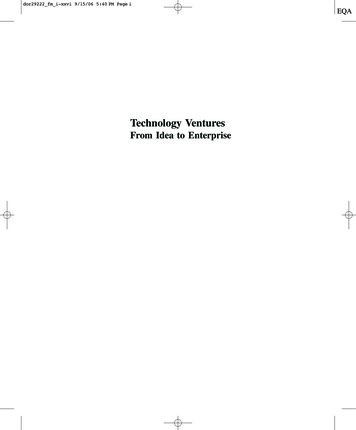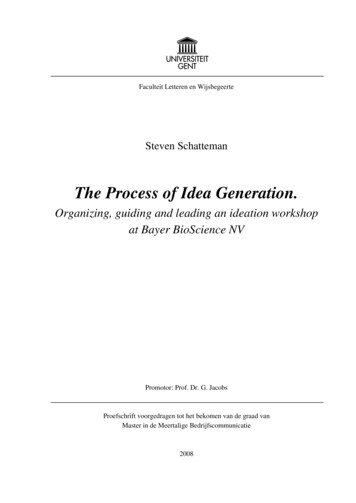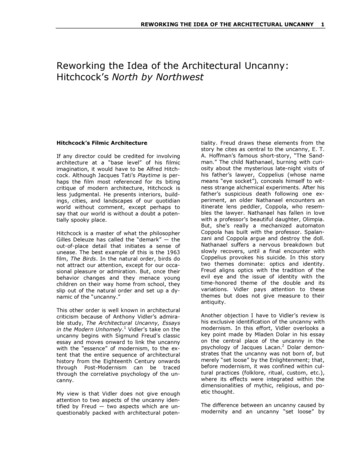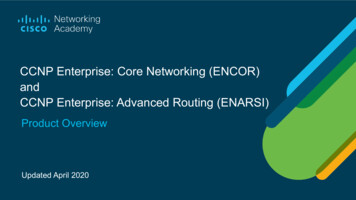
Transcription
dor29222 fm i-xxvi 9/15/06 5:40 PM Page iTechnology VenturesFrom Idea to Enterprise
dor29222 fm i-xxvi 9/15/06 9:22 PM Page ii
dor29222 fm i-xxvi 9/15/06 5:40 PM Page iiiTechnology VenturesFrom Idea to EnterpriseRichard C. DorfUniversity of California, DavisThomas H. ByersStanford University
dor29222 fm i-xxvi 9/15/06 5:40 PM Page ivTECHNOLOGY VENTURES: FROM IDEA TO ENTERPRISE, SECOND EDITIONPublished by McGraw-Hill, a business unit of The McGraw-Hill Companies, Inc., 1221 Avenue of the Americas,New York, NY 10020. Copyright 2008 by The McGraw-Hill Companies, Inc. All rights reserved. No part of thispublication may be reproduced or distributed in any form or by any means, or stored in a database or retrieval system, without the prior written consent of The McGraw-Hill Companies, Inc., including, but not limited to, in anynetwork or other electronic storage or transmission, or broadcast for distance learning.Some ancillaries, including electronic and print components, may not be available to customers outside theUnited States.This book is printed on acid-free paper.1 2 3 4 5 6 7 8 9 0 DOC/DOC 0 9 8 7 6ISBN 978–0–07–352922–6MHID 0–07–352922–2Senior Sponsoring Editor: Michael S. HackettDevelopmental Editor: Kathleen L. WhiteExecutive Marketing Manager: Michael WeitzProject Coordinator: Tracy L. KonrardySenior Production Supervisor: Sherry L. KaneAssociate Media Producer: Christina NelsonDesigner: John JoranCompositor: TechbooksTypeface: 10.5/12 Times RomanPrinter: R. R. Donnelley Crawfordsville, INLibrary of Congress Cataloging-in-Publication DataDorf, Richard C.Technology ventures : from idea to enterprise / Richard C. Dorf, Thomas H. Byers. — 2nd ed.p. cm.Includes index.ISBN 978–0–07–352922–6 — ISBN 0–07–352922–2 (hard copy : alk. paper)1. Information technology. 2. Entrepreneurship. 3. New business enterprises. I. Byers, Thomas (Thomas H.).II. 06023211CIP
dor29222 fm i-xxvi 9/15/06 5:40 PM Page vDEDICATIONFor our spouses: Joy M. Dorf and Michele L. Mandell.We recognize their love and commitment to thispublication that will help others create importanttechnology ventures for the benefit of all.RICHARD C. DORF, THOMAS H. BYERS
dor29222 fm i-xxvi 9/15/06 5:40 PM Page viABOUT THE AUTHORSis professor of electrical and computer engineering and professor of management at the University of California, Davis. He is a Fellow ofthe American Society for Engineering Education (ASEE) in recognition of hisoutstanding contributions to the society, as well as a Fellow of the Institute ofElectrical and Electronic Engineering (IEEE). The best-selling author of Introduction to Electric Circuits (7th Ed.), Modern Control Systems (10th Ed.),Handbook of Electrical Engineering (3rd Ed.), Handbook of Engineering (2ndEd.), and Handbook of Technology Management, Dr. Dorf is cofounder of sixtechnology firms.Richard C. DorfThomas H. Byers is professor of management science and engineering atStanford University and founder of its Stanford Technology Ventures Program,which is dedicated to accelerating high-technology entrepreneurship educationaround the globe. After receiving his B.S., MBA, and Ph.D. from the University of California, Berkeley, Dr. Byers spent over a decade in leadership positions in technology ventures including Symantec Corporation. His teachingawards include Stanford’s highest honor in 2005 and three national awards forentrepreneurship educators.
dor29222 fm i-xxvi 9/15/06 8:01 PM Page viiBRIEF CONTENTSForeword,xiiiPreface, xvIPA RTV E N T U R E O P P O R T U N I T Y, C O N C E P T,A N D S T R AT E G Y1 Capitalism and the Technology Entrepreneur2 Opportunity and the Business Summary3 Building a Competitive Advantage4 Creating a StrategyII2759815 Innovation StrategiesPA RT3103V E N T U R E F O R M AT I O N A N D P L A N N I N G6 Risk and Return1337 Venture Creation and the Business Plan1578 Independent Versus Corporate Ventures1779 Knowledge, Learning, and Design20310 Legal Formation and Intellectual Property225IIIPA RTD E TA I L E D F U N C T I O N A L P L A N N I N G F O RTHE VENTURE11 The Marketing and Sales Plan24512 The New Enterprise Organization27313 Acquiring, Organizing, and Managing Resources14 The Management of Operations29931915 Acquisitions, Mergers, and Global Business339vii
dor29222 fm i-xxvi 9/15/06 8:01 PM Page viiiviiiBrief ContentsIVPA RTFINANCING AND BUILDINGTHE VENTURE16 The Profit and Harvest Plan17 The Financial Plan37918 Sources of Capital40335719 Presenting the Plan and Negotiating the Deal20 Leading a New Technology Venture to 641651441455
dor29222 fm i-xxvi 9/15/06 8:01 PM Page ixCONTENTSForeword,Preface,xiiixvIPA RTV E N T U R E O P P O R T U N I T Y,C O N C E P T, A N D S T R AT E G Y2.62.72.8Chapter 1Capitalism and the TechnologyEntrepreneur 31.11.23.6Chapter 2Opportunity and the Business Summary 272.12.22.32.42.5Opportunity Identification 28Trends, Convergence, and Opportunities 32The Entrepreneur and Opportunity 36Evaluating the Opportunity 41The Decision to Act or Continue LookingElsewhere 4650Chapter 3Building a Competitive Advantage 593.13.23.33.43.5The Entrepreneur and the Challenge 4Entrepreneurial Activity Based onInnovation and Technology 71.3 Entrepreneurial Capital and the Value of aVenture 111.4 Building an Enterprise 141.5 Economics, the Entrepreneur, andProductivity 151.6 The Knowledge Economy 171.7 The Firm 201.8 Dynamic Capitalism and CreativeDestruction 221.9 The Sequential Case: AgraQuest 231.10 Summary 24The New Venture Story and SummaryAgraQuest 55Summary 563.73.83.9The Vision 60The Mission Statement 63The Value Proposition 64The Business Model 67Business Model Innovation in ChallengingMarkets 71Core Competencies and CompetitiveAdvantage 72Sustainable Competitive Advantage 73AgraQuest 76Summary 78Chapter 4Creating a Strategy 814.14.24.34.44.54.64.74.8Venture Strategy 82The Industry and Context for a Firm 85Strengths and Opportunities—SWOTAnalysis 89Barriers to Entry 91Achieving a Sustainable CompetitiveAdvantage 92Matching Tactics to Markets 95AgraQuest 99Summary 100Chapter 5Innovation Strategies 1035.15.2First Movers Versus FollowersImitation 110104ix
dor29222 fm i-xxvi 9/15/06 8:01 PM Page xx5.35.45.55.65.75.85.9ContentsAlliances 111Creativity and Invention 114Technology and Innovation StrategyTypes of Innovation 121New Technology Ventures 124AgraQuest 127Summary 1298.61178.88.9Chapter 9Knowledge, Learning, and Design 203IIPA RTV E N T U R E F O R M AT I O NAND PLANNINGChapter 6Risk and Return 1336.16.26.36.46.56.66.7Risk and Uncertainty 134Scale and Scope 142Network Effects and Increasing Returns 146Finding Disruptive Applications 151Risk Versus Return 152AgraQuest 153Summary 154Chapter 7Venture Creation and the Business Plan 1577.17.27.37.47.57.68.7Incentives for CorporateVentureSuccess 191Building and Managing CorporateVentures 194AgraQuest 200Summary 200Building a New Business 158The Business Plan 159Cluster Dynamics 166The Socially Responsible Firm 168AgraQuest 173Summary 1749.19.29.39.49.59.69.79.8The Knowledge of an Organization 204Managing Knowledge Assets 205Learning Organizations 206Product Design and Development 211Product Prototypes 216Scenarios 219AgraQuest 221Summary 222Chapter 10Legal Formation and IntellectualProperty 22510.110.210.310.410.510.610.710.810.910.10Legal Form of the Firm 226Company Name 229Intellectual Property 230Trade Secrets 232Patents 233Trademarks 237Copyrights 238Licensing 238AgraQuest 239Summary 240IIIChapter 8Independent Versus Corporate Ventures 177PA RTD E TA I L E DFUNCTIONAL PLANNING FORTHE VENTURE8.18.28.3Chapter 11The Marketing and Sales Plan8.48.5Types of New Ventures 178Nonprofit and Public Sector VenturesFamily-Owned Businesses andFranchising 183Corporate New Ventures 186The Innovator’s Dilemma 18917911.111.2245Marketing 246Marketing Objectives and Customer TargetSegments 247
dor29222 fm i-xxvi 9/15/06 8:01 PM Page xiContents11.311.411.511.611.711.8Product and Offering Description 249Market Research 250Brand Equity 252Marketing Mix 254Customer Relationship Management 258Diffusion of Technology andInnovations 26111.9 Crossing the Chasm 26311.10 Personal Selling and the Sales Force 26711.11 AgraQuest 26911.12 Summary 271Chapter 12The New Enterprise Organization 2.1212.13The New Venture Team 274Organizational Design 275Leadership 278Teams 282Management 284Emotional Intelligence 285Organizational Culture 286Social Capital 289Attracting and Retaining Talent 291Ownership and Stock Options 293Board of Directors 294AgraQuest 296Summary 297Chapter 13Acquiring, Organizing, and ManagingResources 29913.113.213.313.413.513.613.713.8Acquiring Resources and Capabilities 300Influence and Persuasion 302Location 303Facility Planning 304Telecommuting and Teleconferencing 305The Internet 305Vertical Integration and Outsourcing 308Innovation and Virtual Organizations 312xi13.9Acquiring Technology andKnowledge 31413.10 AgraQuest 31513.11 Summary 316Chapter 14The Management of Operations14.114.214.314.414.514.614.7319The Value Chain 320Processes and OperationsManagement 323The Value Web 328Strategic Control and the BalancedScorecard 330Scheduling and Operations 333AgraQuest 334Summary 336Chapter 15Acquisitions, Mergers, andGlobal Business 33915.115.215.315.415.5Acquisitions and Mergers and the Questfor Synergy 340Acquisitions and Mergers as a GrowthStrategy 342Global Business 347AgraQuest 352Summary 353IVPA RTFINANCING ANDBUILDING THE VENTUREChapter 16The Profit and Harvest Plan16.116.216.316.416.516.616.7357The Revenue Model 358The Profit Model 359Managing Revenue GrowthThe Harvest Plan 370Exit and Failure 373AgraQuest 375Summary 376364
dor29222 fm i-xxvi 9/15/06 8:01 PM Page xiixiiContentsChapter 17The Financial Plan 37919.419.517.117.217.317.417.517.617.7Building a Financial Plan 380Sales Projections 382Costs Forecast 383Income Statement 383Cash Flow Statement 383Balance Sheet 386Results for a PessimisticGrowth Rate 38917.8 Breakeven Analysis 39217.9 Measures of Profitability 39717.10 AgraQuest 39817.11 Summary 39919.619.7Chapter 20Leading a New Technology Venture toSuccess 45520.120.220.320.420.520.6Chapter 18Sources of Capital 8.1218.13Financing the New Venture 404Venture Investments asReal Options 406Sources of Capital 409Bootstrap and Seed Financing 411Angels 412Venture Capital 414Corporate Venture Capital 420Valuation 421Terms of the Deal 426Debt Financing 427Initial Public Offering 428AgraQuest 436Summary 437The New Venture Story 442The Short Version of the StoryThe Presentation 446Execution of the Business PlanStages of a Business 459The Adaptive Enterprise 465Ethics 469AgraQuest 472Summary 473ReferencesChapter 19Presenting the Plan and Negotiating theDeal 44119.119.219.3Negotiating the Deal 448Critical Issues for theBusiness Plan 450AgraQuest 452Summary 453445456476AppendicesA. Business Plans 491EZGuard 492I-MOS SemiconductorsB. Cases509537World Indigo Inc. 538Biodiesel Incorporated 565Yahoo! 1995 569Barbara Arneson 585Jon Hirschtick’s New Venture 589Artemis Images 602RADCO Electronics 623C. Information Sources on the InternetGlossaryIndex641651636
dor29222 fm i-xxvi 9/15/06 5:40 PM Page xiiiFOREWORDby John L. Hennessy, President of Stanford UniversityI am delighted to see this book on technology entrepreneurship by Dorf andByers. High-technology companies are both an important part of our world’seconomic growth story as well as the place where many young entrepreneursrealize their dreams.Unfortunately, there have been relatively few complete and analyticalbooks on high-technology entrepreneurship. Dorf and Byers bring their yearsof experience in teaching to this book, and it shows. Their personal experiences as entrepreneurs are also clear throughout the book. Their connectionsand involvement with start-ups—ranging from now established companies likeSun Microsystems and Yahoo to new ventures just delivering their firstproducts—add a tremendous amount of real-world insight and relevance.One of the most impressive aspects of this book is its broad coverage ofthe challenges involved in high-technology entrepreneurship. Part I talks aboutthe core issues involved in deciding to pursue an entrepreneurial vision andwhat characteristics are vital to success from the very beginning. I am pleasedto see that building and maintaining a competitive advantage and the criticalissue of market timing are key topics. During the Internet boom, while severalgreat new companies were built, too many entrepreneurs and investors forgotseveral key principles: have a sustainable advantage, create a significant barrierto entry, and be a leader when the market and the technology are both ready.Hopefully, the material in these chapters will help prevent future irrationalbehavior by both entrepreneurs and investors.Part II examines the major strategic decisions that any group of entrepreneurs must grapple with: how to balance risk and return, what entrepreneurialstructure to pursue, how to find and cultivate the best employees and help makethem productive, and the critical issues of intellectual property. Indeed, theseare problems that every company faces, and ones that must be continuouslyexamined by the leadership in any organization.Part III discusses the operational and organizational challenges that all entrepreneurs must tackle. Virtually every start-up led by a technologist that I havebeen close to inevitably wonders whether it needs sales and marketing. Sometimes in such companies, you hear a remark like: “We have great technology andthat will bring us customers; nothing else matters!” I remind them that withoutsales, there is no revenue, and without marketing, sales will be diminished.Understanding how to approach these vital aspects of any successful business iscrucial. The related topics of building the organization, thi
13.8 Innovation and Virtual Organizations 312 13.9 Acquiring Technology and Knowledge 314 13.10 AgraQuest 315 13.11 Summary 316 Chapter 14 The Management of Operations 319 14.1 The Value Chain 320 14.2 Processes and Operations Management 323 14.3 The Value Web 328 14.4 Strategic Control and the Balanced Scorecard 330 14.5 Scheduling and .











